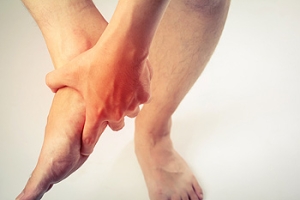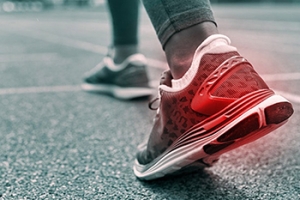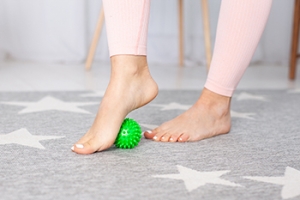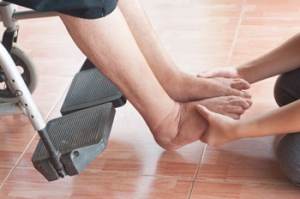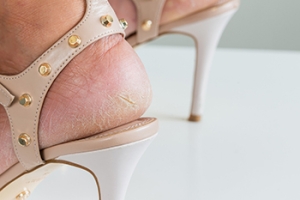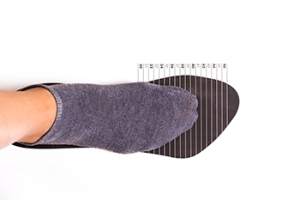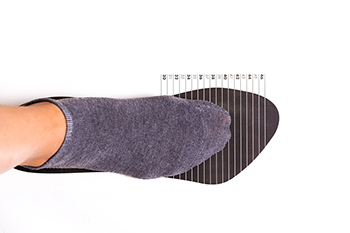
Causes of Foot Pain
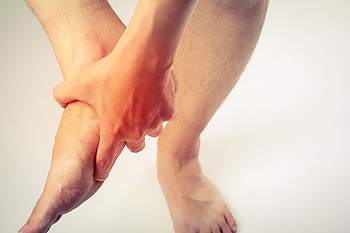
Pain can be felt in the feet for a multitude of reasons, including aging, prolonged standing, walking, being overweight, structural problems with feet, foot injuries, poor fitting foot coverings, or a physical condition, such as arthritis or gout. Painful foot conditions can arise out of the aforementioned risk factors, like bunions, calluses, corns, hammertoes, Morton’s neuroma, plantar fasciitis, or heel spurs. If you are experiencing pain in your feet and you cannot easily figure out what it is from or what to do about it, consider consulting with a podiatrist for proper diagnosis and treatment.
Foot Pain
Foot pain can be extremely painful and debilitating. If you have a foot pain, consult with one of our podiatrists from Florida Ankle & Foot Institute. Our doctors will assess your condition and provide you with quality foot and ankle treatment.
Causes
Foot pain is a very broad condition that could be caused by one or more ailments. The most common include:
- Bunions
- Hammertoes
- Plantar Fasciitis
- Bone Spurs
- Corns
- Tarsal Tunnel Syndrome
- Ingrown Toenails
- Arthritis (such as Gout, Rheumatoid, and Osteoarthritis)
- Flat Feet
- Injury (from stress fractures, broken toe, foot, ankle, Achilles tendon ruptures, and sprains)
- And more
Diagnosis
To figure out the cause of foot pain, podiatrists utilize several different methods. This can range from simple visual inspections and sensation tests to X-rays and MRI scans. Prior medical history, family medical history, and any recent physical traumatic events will all be taken into consideration for a proper diagnosis.
Treatment
Treatment depends upon the cause of the foot pain. Whether it is resting, staying off the foot, or having surgery; podiatrists have a number of treatment options available for foot pain.
If you have any questions, please feel free to contact our offices located in Tavernier, Marathon, and Key West, FL . We offer the newest diagnostic and treatment technologies for all your foot care needs.
Foot Pain
The feet, being the foundation of the body, carry all of the body’s weight and are therefore prone to experiencing pain and discomfort. If you are experiencing foot pain, it is important to determine where in the foot you are experiencing this pain to help discover the cause of it. While pain can be experienced virtually anywhere in the foot, the most common sites of foot pain are in the heel and ankle.
Heel pain can be due to a multitude of conditions including plantar fasciitis, Achilles tendinitis, and heel spurs. Pain experienced in the ankle can be a sign of an ankle sprain, arthritis, gout, ankle instability, ankle fracture, or nerve compression. In more serious cases, pain in the foot can be a sign of improper alignment or an infection.
Foot pain can be accompanied by symptoms including redness, swelling, stiffness and warmth in the affected area. Whether the pain can be described as sharp or dull depends on the foot condition behind it. It is important to visit your local podiatrist if your foot pain and its accompanying symptoms persist and do not improve over time.
Depending on the location and condition of your foot pain, your podiatrist may prescribe certain treatments. These treatments can include but are not limited to prescription or over-the-counter drugs and medications, certain therapies, cortisone injections, or surgery.
If you are experiencing persistent foot pain, it is important to consult with your foot and ankle doctor to determine the cause and location. He or she will then prescribe the best treatment for you. While milder cases of foot pain may respond well to rest and at-home treatments, more serious cases may take some time to fully recover.
Several Differences Between Walking and Running Shoes
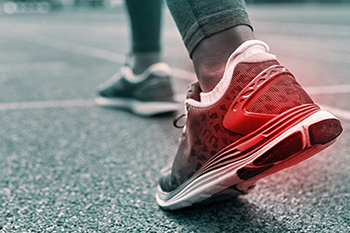 Walking and running are two completely different activities that impact different parts of the feet. Research has shown it is beneficial to wear shoes that can complement different running and walking styles. One of the differences between the two types of shoes has to do with the type of sole. Running shoes have stiffer and sturdier soles than walking shoes. This is helpful in providing the necessary stability while running. Proper walking shoes have a flexible sole, and the heels tend to be heavier than those of running shoes. Additionally, the shoes are made of different materials. Running shoes are made of breathable fabrics, which can help when feet become sweaty. A portion of the shoe that is referred to as the counter can help provide a secure fit. In walking shoes, the heel is tilted, and the toe area is stiff. Please confer with a podiatrist who can provide you with more information about the differences between walking and running shoes.
Walking and running are two completely different activities that impact different parts of the feet. Research has shown it is beneficial to wear shoes that can complement different running and walking styles. One of the differences between the two types of shoes has to do with the type of sole. Running shoes have stiffer and sturdier soles than walking shoes. This is helpful in providing the necessary stability while running. Proper walking shoes have a flexible sole, and the heels tend to be heavier than those of running shoes. Additionally, the shoes are made of different materials. Running shoes are made of breathable fabrics, which can help when feet become sweaty. A portion of the shoe that is referred to as the counter can help provide a secure fit. In walking shoes, the heel is tilted, and the toe area is stiff. Please confer with a podiatrist who can provide you with more information about the differences between walking and running shoes.
For more information about walking shoes versus running shoes, consult with one of our podiatrists from Florida Ankle & Foot Institute. Our doctors can measure your feet to determine what your needs are and help you find an appropriate pair of footwear.
Foot Health: The Differences between Walking & Running Shoes
There are great ways to stay in shape: running and walking are two great exercises to a healthy lifestyle. It is important to know that running shoes and walking shoes are not interchangeable. There is a key difference on how the feet hit the ground when someone is running or walking. This is why one should be aware that a shoe is designed differently for each activity.
You may be asking yourself what the real differences are between walking and running shoes and the answers may shock you.
Differences
Walking doesn’t involve as much stress or impact on the feet as running does. However, this doesn’t mean that you should be any less prepared. When you’re walking, you land on your heels and have your foot roll forward. This rolling motion requires additional support to the feet.
Flexibility – Walking shoes are designed to have soft, flexible soles. This allows the walker to push off easily with each step.
If you have any questions, please feel free to contact our offices located in Tavernier, Marathon, and Key West, FL . We offer the newest diagnostic and treatment technologies for all your foot care needs.
Walking Shoes vs. Running Shoes
Although walking shoes and running shoes look similar, they have characteristics that make them different from each other. Runners should avoid running in walking shoes and vice versa. It is very important that you wear the proper footwear for the activity you are going to partake in, for you to avoid injury.
If you are looking to buy a new pair of running shoes, there are certain things you should look out for. One of the main components that makes up a good running shoe is flexibility. You should be able to bend and flex the forefoot of the shoe that you are purchasing. If you can bend the entire shoe in half with ease, this is a sign that the shoe does not have enough structure for your feet. Another feature you should look for is a low heel. Certain running shoes have a low heel to support runners who land on the ball of their feet. Lastly, you should look for the fit of the running shoe. You should visit the best running shoe store in your area to have your feet properly sized for the shoes in the store. Usually, the staff will be able to help recommend the best type of running shoe for your needs.
When you are walking, the body’s weight is evenly distributed on the foot. This influences the design of shoes made for walking. If you are looking to buy a pair of walking shoes, there are different features you should look for to determine which pair of shoes is best for you. Walking shoes should be flexible through the ball of the foot to allow for a greater range of motion through the roll of the forefoot. These shoes also should have greater arch support for the foot. If you plan on walking long distances or on hard surfaces, it is best that you wear shoes that have cushioning.
When trying on a new pair of shoes, the heel should fit snugly without slip. You should shop for shoes after a long walk, since your feet tend to swell throughout the day. Many people have one foot that is a different size than the other, so it is best that you have both feet measured when looking for your true size. You should also beware that sizes vary depending on the shoe brand. A certain size in one brand may be a different size in a different brand. Lastly, you should always walk around in shoes that you plan on buying. This will help you determine whether the shoes are comfortable and if they fit well on your feet.
Always look for good shoe construction when shopping for new sneakers. The upper part of the shoe should allow for adjustment through laces or straps. If you need help with shoe sizing or if you need custom orthotics for your feet, you should make an appointment with your podiatrist for assistance. He or she will be more than happy to help you with your shoe sizing needs.
A Tennis Ball and the Sole of the Feet
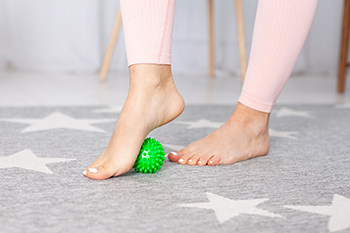 There are many people who understand the benefits of exercising their feet. One way this can be accomplished is by using a tennis ball. This is done by rolling the bottom of the foot on the tennis ball, which may be beneficial in strengthening the overall foot. When this is practiced, it can help to release tension in the feet, and specific types of foot pain may gradually diminish. Research has indicated it may have a positive effect on the brain and nervous system. There are different points of the foot that correspond to specific internal organs. Improvement and good feelings may be noticed when these parts of the foot are massaged with a tennis ball. If you would like additional information about what size tennis ball to use that can help your feet, please ask a podiatrist.
There are many people who understand the benefits of exercising their feet. One way this can be accomplished is by using a tennis ball. This is done by rolling the bottom of the foot on the tennis ball, which may be beneficial in strengthening the overall foot. When this is practiced, it can help to release tension in the feet, and specific types of foot pain may gradually diminish. Research has indicated it may have a positive effect on the brain and nervous system. There are different points of the foot that correspond to specific internal organs. Improvement and good feelings may be noticed when these parts of the foot are massaged with a tennis ball. If you would like additional information about what size tennis ball to use that can help your feet, please ask a podiatrist.
Exercising your feet regularly with the proper foot wear is a great way to prevent injuries and build strength. If you have any concerns about your feet, contact one of our podiatrists from Florida Ankle & Foot Institute. Our doctors can provide the care you need to keep you pain-free and on your feet.
Exercise for Your Feet
Exercise for your feet can help you gain strength, mobility and flexibility in your feet. They say that strengthening your feet can be just as rewarding as strengthening another part of the body. Your feet are very important, and we often forget about them in our daily tasks. But it is because of our feet that are we able to get going and do what we need to. For those of us fortunate enough to not have any foot problems, it is an important gesture to take care of them to ensure good health in the long run.
Some foot health exercises can include ankle pumps, tip-toeing, toe rises, lifting off the floor doing reps and sets, and flexing the toes. It is best to speak with Our doctors to determine an appropriate regimen for your needs. Everyone’s needs and bodies are different, and the activities required to maintain strength in the feet vary from individual to individual.
Once you get into a routine of doing regular exercise, you may notice a difference in your feet and how strong they may become.
If you have any questions please feel free to contact our offices located in Tavernier, Marathon, and Key West, FL . We offer the newest diagnostic and treatment technologies for all your foot and ankle needs.
Exercise for Your Feet
Whether your feet are over-worked or under-worked, chances are they could benefit from some special attention. Even those who exercise regularly probably do not spend any time strengthening their feet. This can be just as rewarding as strengthening the rest of the body, since the health of your feet affects the health of the rest of the body as well, especially the ankles, legs, and spine.
For those who might not have any idea on how a foot-specific exercise might be conducted, there are several workouts that are fairly easy to perform in the comfort of ones’ home. One of the easiest is the toe rise, also known as the tip-toe. This exercise involves standing on the tip-toes for a count of 15 then resting the feet on the ground. This process should be repeated a minimum of three times a day in order to strengthen the feet.
Toe pick-ups strengthen the feet by working them in a very different way. In this exercise, small items are picked up using the toes in order to strengthen the muscles on the upper part of the feet. Once again three sets should be performed, with the item in question being held for 15 seconds then dropped. Items that may be picked up using the feet include marbles and even stationery, which works wonders for the toes and the surrounding muscles.
Yet another simple workout is the ankle pump. This can be done either upwards or downwards, but for the workout to be most effective both can be incorporated into the routine. As the term suggests, this involves lifting the foot off the floor and flexing the toes either towards the shin or towards the ground. This movement puts the feet and ankles through a large range of motion which works the muscles.
Last but not least, feet should be stretched so that the muscles can relax and recuperate. This can be done by placing both feet off of the floor and bracing oneself against the wall at a 45 degree angle. This ensures that the feet and ankles are adequately stretched once the workout is complete.
In short, giving the feet a good workout every now and then is important in order to avoid problems such as plantar fasciitis. It’s also important to warm-up or cool-down after running or vigorous walking. Foot exercises may be followed by a good foot massage. This encourages circulation in the feet as well as muscle relaxation.
How to Best Care For Elderly Feet
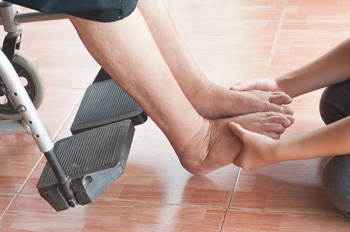 Since it's said that 75% of seniors experience foot problems as they age, it stands to reason that foot care is an important part of their overall health care. If seniors maintain the health of their feet, they will be able to stay active longer, keep better balance and prevent falls (a key reason for injury and hospitalization in elderly years), and remain aware of signs that other health issues might be present (such as diabetes, arthritis and other serious conditions). The elderly should check their feet each day to make sure there is nothing visible that appears unusual (like blisters, swelling, or infections), wash and dry feet daily, trim toenails regularly, tend to any corn or callus, moisturize the tops and bottoms of feet if the skin is dry or cracked, wear well-fitting shoes and socks, and make sure socks are clean and do not restrict circulation or irritate the feet in any way. Regular exercise, eating healthy, and stopping smoking may also contribute to foot health. If a senior is unable to tend to their feet by themselves, it is advisable to set up routine visits with a podiatrist to maintain proper foot care and diagnose and treat any problems as they arise.
Since it's said that 75% of seniors experience foot problems as they age, it stands to reason that foot care is an important part of their overall health care. If seniors maintain the health of their feet, they will be able to stay active longer, keep better balance and prevent falls (a key reason for injury and hospitalization in elderly years), and remain aware of signs that other health issues might be present (such as diabetes, arthritis and other serious conditions). The elderly should check their feet each day to make sure there is nothing visible that appears unusual (like blisters, swelling, or infections), wash and dry feet daily, trim toenails regularly, tend to any corn or callus, moisturize the tops and bottoms of feet if the skin is dry or cracked, wear well-fitting shoes and socks, and make sure socks are clean and do not restrict circulation or irritate the feet in any way. Regular exercise, eating healthy, and stopping smoking may also contribute to foot health. If a senior is unable to tend to their feet by themselves, it is advisable to set up routine visits with a podiatrist to maintain proper foot care and diagnose and treat any problems as they arise.
Proper foot care is something many older adults forget to consider. If you have any concerns about your feet and ankles, contact one of our podiatrists from Florida Ankle & Foot Institute. Our doctors can provide the care you need to keep you pain-free and on your feet.
The Elderly and Their Feet
As we age we start to notice many changes in our body, but the elder population may not notice them right away. Medical conditions may prevent the elderly to take notice of their foot health right away. Poor vision is a lead contributor to not taking action for the elderly.
Common Conditions
- Neuropathy – can reduce feeling in the feet and can hide many life-threatening medical conditions.
- Reduced flexibility – prevents the ability of proper toenail trimming, and foot cleaning. If left untreated, it may lead to further medical issues.
- Foot sores – amongst the older population can be serious before they are discovered. Some of the problematic conditions they may face are:
- Gouging toenails affecting nearby toe
- Shoes that don’t fit properly
- Pressure sores
- Loss of circulation in legs & feet
- Edema & swelling of feet and ankles
Susceptible Infections
Diabetes and poor circulation can cause general loss of sensitivity over the years, turning a simple cut into a serious issue.
If you have any questions please feel free to contact our offices located in Tavernier, Marathon, and Key West, FL . We offer the newest diagnostic and treatment technologies for all your foot and ankle needs.
Possible Causes of Cracked Heels
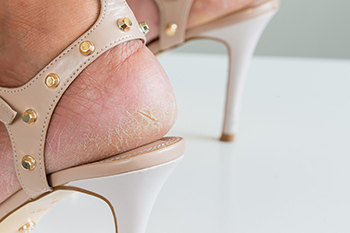 Many patients experience the uncomfortable foot condition that is referred to as cracked heels. It can be caused by living in a dry climate or it may develop from specific medical conditions, including eczema and psoriasis. Additionally, patients can have cracked heels from wearing shoes that have an open back. Relief may be found when the feet are washed and dried thoroughly, followed by using a good moisturizer. It can help to drink plenty of fresh water daily, in addition to wearing shoes that are made of breathable materials. Cracked heels can become painful so it is suggested that you schedule an appointment with a podiatrist who can offer you correct treatment solutions.
Many patients experience the uncomfortable foot condition that is referred to as cracked heels. It can be caused by living in a dry climate or it may develop from specific medical conditions, including eczema and psoriasis. Additionally, patients can have cracked heels from wearing shoes that have an open back. Relief may be found when the feet are washed and dried thoroughly, followed by using a good moisturizer. It can help to drink plenty of fresh water daily, in addition to wearing shoes that are made of breathable materials. Cracked heels can become painful so it is suggested that you schedule an appointment with a podiatrist who can offer you correct treatment solutions.
Cracked heels are unsightly and can cause further damage to your shoes and feet. If you have any concerns, contact one of our podiatrists from Florida Ankle & Foot Institute. Our doctors can provide the care you need to keep you pain-free and on your feet.
Cracked Heels
Cracked heels appear unappealing and can make it harder for you walk around in sandals. Aside from looking unpleasant, cracked heels can also tear stockings, socks, and wear out your shoes. There are several methods to help restore a cracked heel and prevent further damage.
How Do You Get Them?
Dry skin is the number one culprit in creating cracked heels. Many athletes, walkers, joggers, and even swimmers suffer from cracked heels. Age and skin oil production play a role to getting cracked heels as well.
Promote Healing
Over the counter medicines can help, especially for those that need instant relief or who suffer from chronic dry feet.
Wear Socks – Wearing socks with medicated creams helps lock in moisture.
Moisturizers – Applying both day and night will help alleviate dryness which causes cracking.
Pumice Stones – These exfoliate and remove dead skin, which allows for smoother moisturizer application and better absorption into the skin.
Change in Diet
Eating healthy with a well-balanced diet will give the skin a fresh and radiant look. Your body responds to the kinds of food you ingest. Omega-3 fatty acids and zinc supplements can also revitalize skin tissue.
Most importantly, seek professional help if unsure how to proceed in treating cracked heels. A podiatrist will help you with any questions or information needed.
If you have any questions, please feel free to contact our offices located in Tavernier, Marathon, and Key West, FL . We offer the newest diagnostic and treatment technologies for all your foot care needs.
What to Do to Keep Your Child’s Feet Healthy
Being a parent involves caring for your child in every way you can. You make sure they are eating the right food, being nice to others, and staying out of any trouble. However, it is also important that you are watchful of their health, more specifically their foot health. Maintaining good foot health in childhood is important in preventing later conditions in life from happening. As children continue to develop, their feet require different techniques of care. Here are some various ways in which you can help your child’s feet stay healthy.
A baby needs a lot of care and attention overall, but the importance of their feet should never be forgotten. Before a baby turns one, their feet change and develop greatly. It is important that during this time, a mother avoids putting tight socks on their child. She should also encourage movement of their feet so the baby can begin to feel more comfortable using them.
As a baby enters the toddler years of his or her life, they are begin to walk around. When your baby begins to take those first steps, it is crucial that they are wearing protective shoes on their feet. As a mother that is observant of your child’s feet, you may notice changes in them. This is completely normal as the feet are becoming susceptible to the activity of walking. It is normal for a toddler to be a bit unsteady or to “walk funny” at first.
When your child grows out of their toddler years, it is important that you begin to show him or her how to care for their feet on their own. Practice with your child proper hygiene in order to prevent foot fungus or infection. Since children are constantly on the move, it is crucial to be cautious of any accidents or injuries that might occur. If an injury occurs, it is advised that you take your child to be examined by a doctor immediately. Since your child is still growing, particular injuries can shift the way in which a bone or other important part of the foot is developing.
Babies and kids are always changing and growing. Your job as a parent is to make sure they stay healthy and making sure they are properly maintained. This involves proper foot care and making sure the feet stay healthy. Following this guide, your child can live a long and happy life.
Improve Your Choice of Footwear While Pregnant
As women gain weight during pregnancy, it is common for their legs and feet to begin swelling and aching. This is mainly a side-effect of the normal buildup of fluids in the body as the baby grows. Further, the center of gravity changes as the months go by, affecting the legs and feet and the way she walks and stands. Proper footwear is essential to help reduce discomfort or the chance of accidents or serious illness. Suggestions for changes in footwear during pregnancy include buying shoes at least a half size larger than normal, choosing shoes with high arch and ankle support, and wearing slip-ons rather than shoes that tie. Further, high heels should be avoided as much as possible, to reduce the chance of falling or twisting an ankle. Low and wider heels help distribute body weight better, and shoes with a wider toe box are a good idea for improved stability and comfort. If you have questions about foot health during pregnancy, it is wise to consult a podiatrist who can guide you in making the proper footwear decisions.
Pregnant women with swollen feet can be treated with a variety of different methods that are readily available. For more information about other cures for swollen feet during pregnancy, consult with one of our podiatrists from Florida Ankle & Foot Institute. Our doctors will attend to all of your foot and ankle needs.
What Foot Problems Can Arise During Pregnancy?
One problem that can occur is overpronation, which occurs when the arch of the foot flattens and tends to roll inward. This can cause pain and discomfort in your heels while you’re walking or even just standing up, trying to support your baby.
Another problem is edema, or swelling in the extremities. This often affects the feet during pregnancy but tends to occur in the later stages.
How Can I Keep My Feet Healthy During Pregnancy?
- Wearing orthotics can provide extra support for the feet and help distribute weight evenly
- Minimize the amount of time spent walking barefoot
- Wear shoes with good arch support
- Wear shoes that allow for good circulation to the feet
- Elevate feet if you experience swelling
- Massage your feet
- Get regular, light exercise, such as walking, to promote blood circulation to the feet
If you have any questions please feel free to contact our offices located in Tavernier, Marathon, and Key West, FL . We offer the newest diagnostic and treatment technologies for all your foot and ankle needs.
